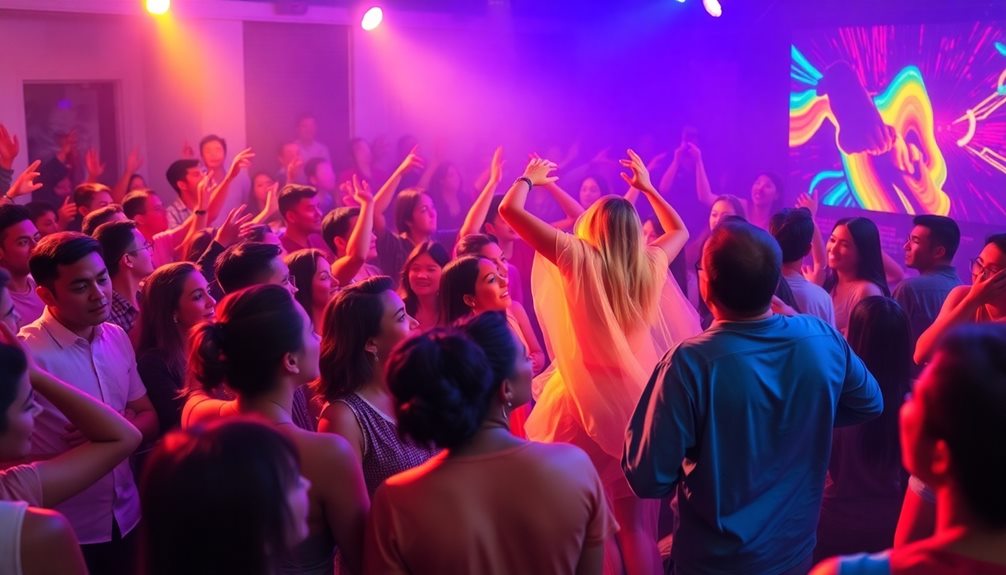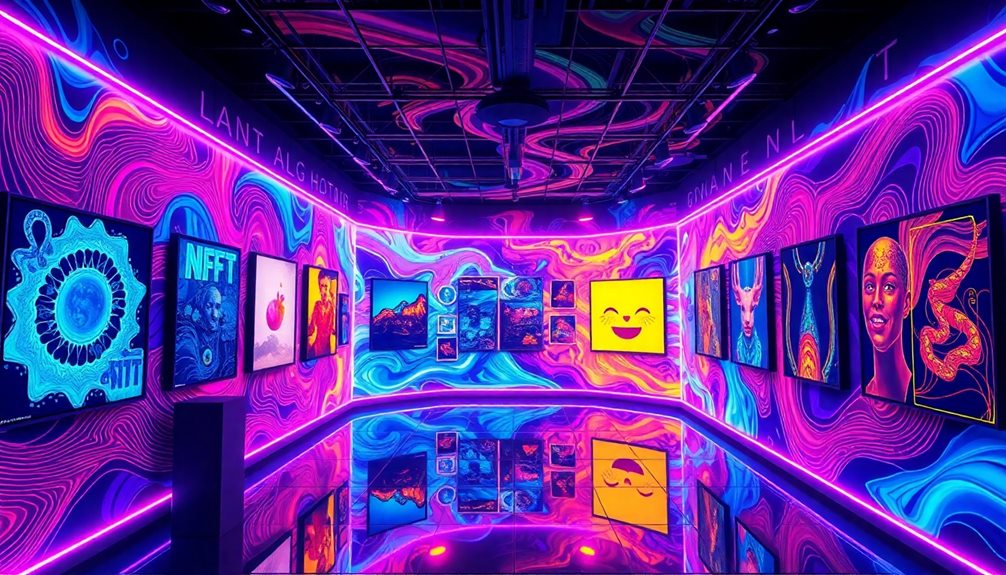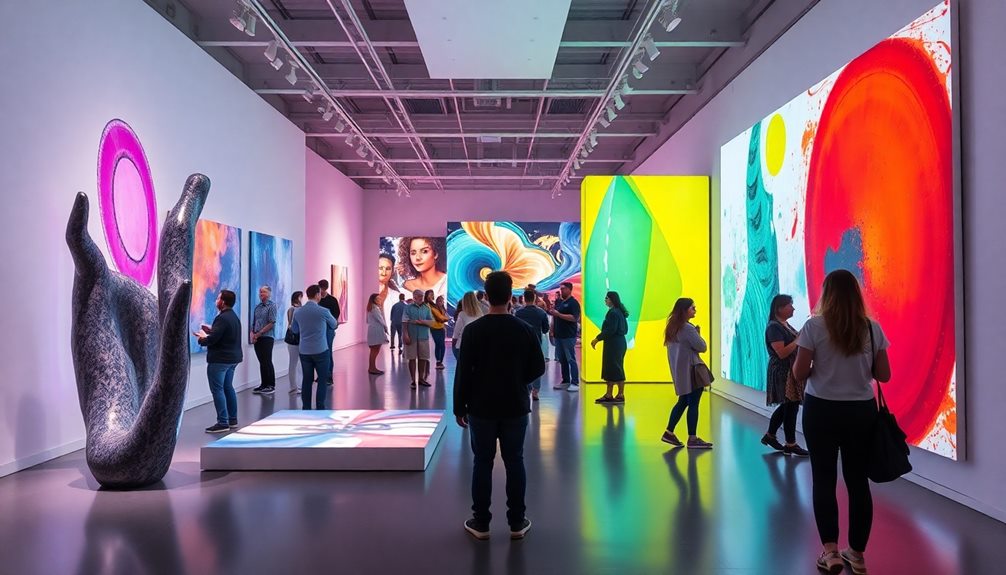Performance art isn't just something to watch; it's an electrifying experience that pulls you into creativity and self-expression. As a viewer, your role shifts from passive observer to active participant, enhancing the emotional resonance of the work. You'll encounter groundbreaking pieces by artists like Yoko Ono and Marina Abramović, who challenge societal norms and evoke deep conversations. The ephemeral nature of these performances invites you to engage in a live shared experience, making your presence essential. Explore how technology and collaboration are reshaping performance art for today's audiences, and you'll find there's much more to discover beyond the surface.
Key Takeaways
- Performance art emphasizes the artist's actions and the shared experience, encouraging audience participation and engagement.
- Understanding the context and themes of a performance can enhance the viewer's experience and interpretation.
- Familiarize yourself with notable artists and their works to appreciate the evolution of performance art.
- The ephemeral nature of performance art means each experience is unique and cannot be replicated.
- Embrace the collaborative spirit of performance art, as it often invites viewers to influence and participate in the creative process.
Historical Context of Performance Art

Performance art has roots that stretch back to the early 20th century, emerging from avant-garde movements like Dada and Futurism. These art movements rejected traditional artistic norms, emphasizing audience engagement and the disruption of conventional expectations.
You'll find that the Fluxus movement in the 1960s played a significant role in shaping performance art, promoting participatory experiences that integrated art with everyday life. Artists encouraged you to interact, breaking down barriers between creator and observer.
In the postwar era, performance art gained recognition in Europe and America, with a significant reliance on documentation through photography and film. This shift changed how you perceive and preserve performances, allowing these fleeting moments to live on.
Key figures like Allan Kaprow popularized Happenings, nonnarrative events that invited your participation and blurred the lines between art and life.
Defining Performance and New Media Art
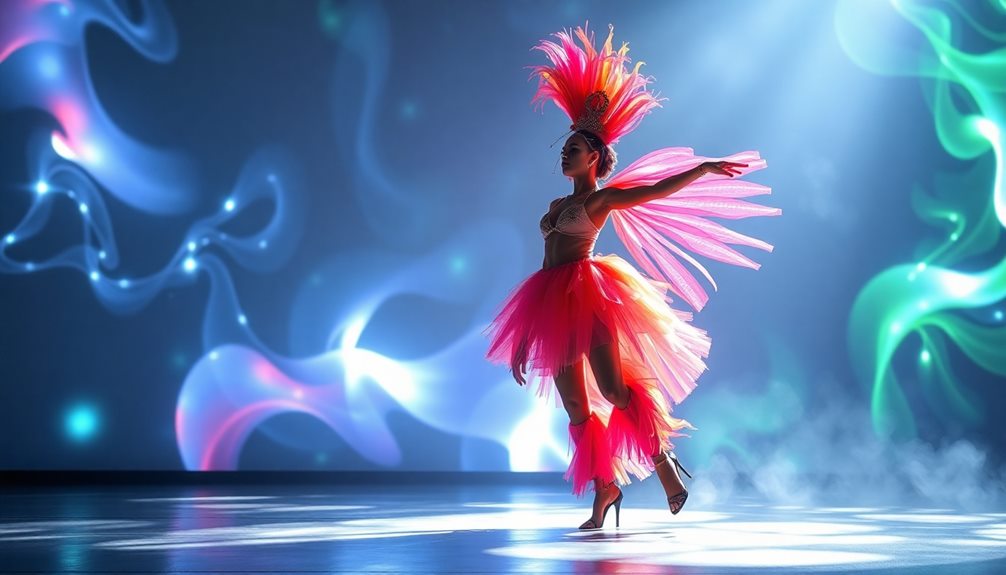
Artistic expression has evolved to encompass a wide range of practices, particularly within performance and new media art.
Performance art focuses on the artist's actions rather than a physical object, using the body as a medium to critique societal roles and challenge the valuation of art. Its ephemeral nature means these works have a specific beginning and end, often blending various materials and technologies to create a rich experience.
New media art, on the other hand, primarily utilizes digital technology, incorporating genres like video, installation, and interactive art. This expansion allows for innovative approaches to visual art, breaking down the traditional boundaries between art and life.
Both performance and new media art engage you as an active participant rather than a passive observer, inviting you to explore the relationship between creator and audience.
The emphasis in both forms lies in the process and act of creation, reflecting the Fluxus movement's ideals of spontaneity, collaboration, and accessibility.
This shift in focus allows for a deeper connection to the art, making your experience more immersive and meaningful as you engage with these dynamic forms of expression.
Engaging With Performance Art

Engaging with performance art transforms your role from a mere observer to an active participant, inviting you to immerse yourself in the experience. This art form breaks down barriers, encouraging audience engagement and emphasizing your involvement in both the creation and interpretation of the artwork.
As you participate, you'll find that artists like Yoko Ono and Carolee Schneemann utilize everyday materials and participatory actions to challenge traditional roles and societal norms.
The ephemeral nature of performance art necessitates your live participation, fostering a shared experience that transcends passive observation. This dynamic redefines the artist-viewer relationship, as your engagement becomes crucial to completing the artwork.
You're not just watching; you're contributing to the narrative and emotional landscape of the performance.
Key questions about control and autonomy surface as you navigate these interactions, prompting essential discussions about the implications of audience engagement on the overall artistic experience.
Embrace this opportunity to explore your creativity and challenge your perceptions, as engaging with performance art invites you to become a co-creator in a moment that will never be replicated.
Notable Artists and Works
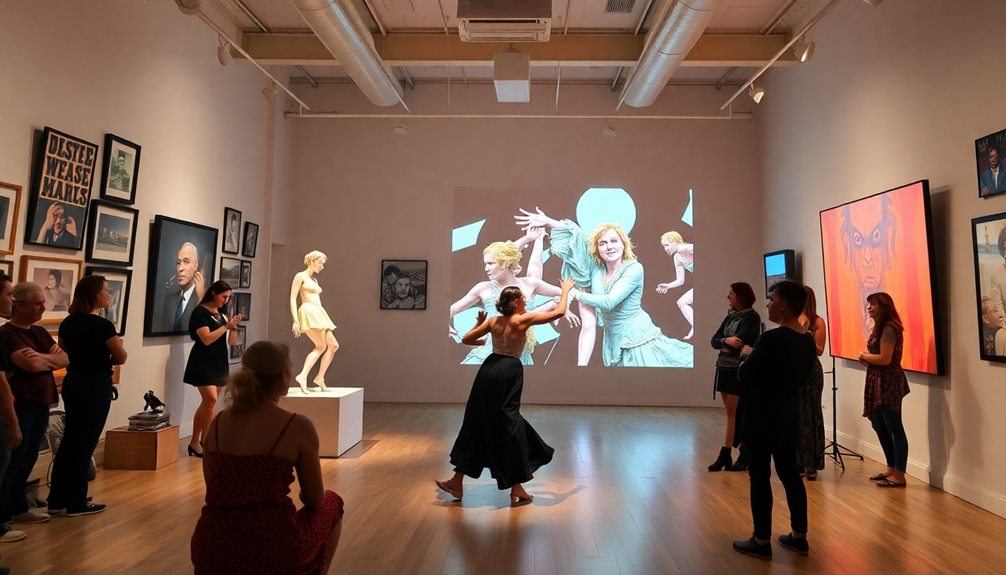
Numerous notable artists have pushed the boundaries of performance art, each leaving a unique mark on the medium. Yoko Ono's *Cut Piece* (1964) invited audience members to cut pieces of her clothing, challenging traditional roles and encouraging viewer participation. This work exemplifies how performance art can create a dialogue between the artist and the audience.
Carolee Schneemann, an influential American artist, showcased her work *Meat Joy* (1964), combining dance and non-art materials to explore sexuality and the body. This piece reflects the vibrant social movements of the 1960s, merging personal experience with broader cultural themes.
Alison Knowles' *Make a Salad* (1962) involved participants in creating a salad, emphasizing everyday materials and individual interpretation in performance art. This work highlights the importance of collaboration and shared experience.
Marina Abramović's *The Artist is Present* (2010) involved her silently engaging with visitors for hours, creating a powerful dialogue about presence and vulnerability.
Each of these artists has considerably contributed to the evolution of performance art, inviting viewers to reconsider their relationships with art and the body.
Societal Impact of New Media Art

The evolution of performance art has paved the way for new media art to emerge as a powerful force in contemporary culture. This form of art democratizes access and enhances audience engagement, allowing you to participate in conversations around pressing societal issues.
Through online platforms and social media, new media art breaks free from traditional gallery confines, inviting diverse voices into the dialogue. Additionally, the integration of technologies such as AI NVIDIA's advanced hardware and machine learning can further enrich the interactive experience, expanding the possibilities for artistic expression.
Here are three key impacts of new media art on society:
- Awareness of Societal Issues: New media art often tackles critical topics like digital rights, environmental concerns, and social justice, encouraging you to reflect on these important themes.
- Collaborative Creation: By challenging conventional notions of authorship and originality, new media art fosters collaborative practices, making you a co-creator in the artistic experience.
- Technological Ethics: The integration of AI, VR, and AR raises ethical questions about authorship and privacy, prompting you to reflect on the implications of surveillance on society.
As you engage with new media art, you're not just a passive viewer; you become part of a broader conversation that shapes our cultural landscape.
Future of Performance Art
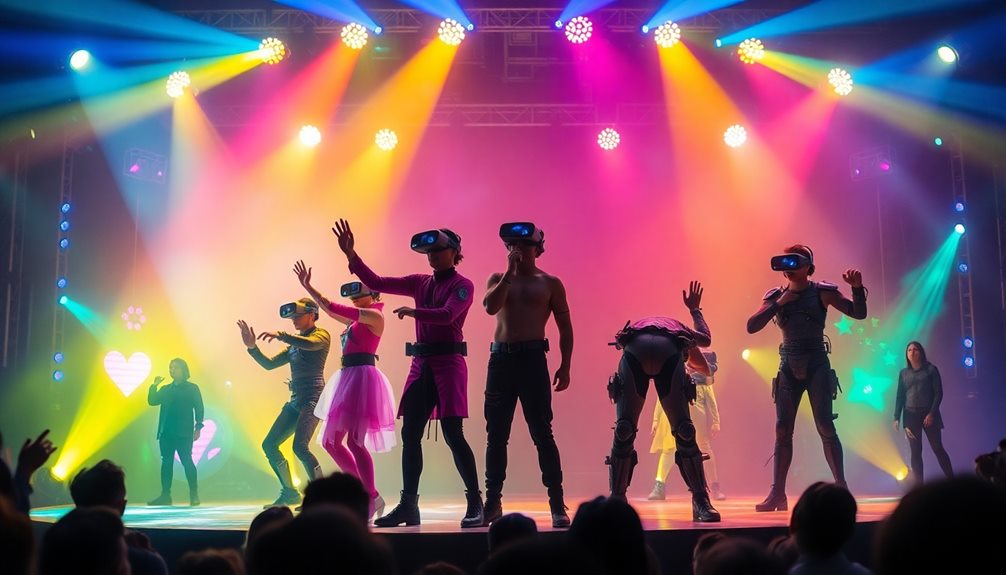
As you explore the future of performance art, you'll notice a thrilling blend of technology reshaping how artists create and audiences engage.
With advancements like VR and AI, expect immersive experiences that redefine participation on a global scale.
This evolution not only enhances collaboration but also raises questions about the role of technology in artistic expression.
Technological Integration in Art
In the evolving landscape of performance art, a wealth of technological innovations is transforming how artists engage with their audiences. This shift opens up immersive experiences, allowing you to witness art in novel ways.
For example, artists are using AI, VR, and AR to create interactive environments that challenge your perceptions of art objects and themes like female sexuality. Additionally, the integration of blockchain technology enhances security and transparency in digital transactions, which is essential for artists selling their work online.
Here are three key ways technology is reshaping performance art:
- Blockchain and NFTs: These technologies establish ownership and provenance, raising questions about authorship and value in the digital art market.
- Live Streaming: New media art platforms enable global participation in real-time, making it possible for even a small audience to engage with performances from anywhere.
- Social Media: Instant sharing facilitates broader dialogues about contemporary issues, enhancing your interaction with the work and the artist.
As technology continues to evolve, performance art will likely explore deeper into themes of surveillance, privacy, and digital rights, reflecting your growing concerns about technology's impact on daily life.
Embrace this transformation, as it offers an exciting glimpse into the future of performance art.
Evolving Audience Interactions
Discover how performance art is evolving to create more dynamic interactions with audiences. As technology advances, artists are tapping into virtual reality (VR) and augmented reality (AR) to craft immersive experiences that enhance your engagement.
Imagine stepping into a digital world where you're not just a spectator but a participant, directly influencing the performance's outcome.
Digital platforms and social media are also revolutionizing how you connect with art. You can now join performances from anywhere, interacting in real-time and feeling like an integral part of the experience.
This shift redefines the artist-viewer relationship, breaking down barriers and encouraging collaboration.
Moreover, performance art is becoming a powerful medium for addressing pressing societal issues. Themes like surveillance, digital rights, and environmental concerns are at the forefront, inviting you to reflect on these topics while participating.
With the integration of blockchain and NFTs, you're offered new ways to engage with and invest in performance art, reshaping ownership and distribution.
As audience participation continues to grow, the future of performance art promises to be more interactive and responsive, allowing you to shape the narrative in unprecedented ways.
Global Artistic Collaborations
Collaboration has become a cornerstone of contemporary performance art, fostering creativity that transcends borders and cultures. Artists are now leveraging advancements in digital technology to engage in global artistic collaborations, allowing for a vibrant exchange of ideas and styles.
Notable figures like Carolee Schneemann have inspired these movements, demonstrating the power of community in artistic expression. This approach mirrors the principles of cultural intelligence (CQ), which emphasizes understanding and adapting to cultural differences, enhancing collaboration across diverse teams.
Here are three key aspects of global artistic collaborations:
- Diverse Perspectives: Collaborations showcase a rich tapestry of cultural narratives, addressing social issues through various performance styles.
- Immersive Experiences: The integration of VR and AR enables artists to create interactive performances that captivate international audiences, breaking down geographical barriers.
- Social Media Influence: Platforms like Instagram and Facebook have become essential tools for artists, enabling them to broadcast live events, interact with viewers, and initiate collaborative projects worldwide.
As you engage with these performances, remember that each piece is a reflection of collective creativity, driven by a shared desire for dialogue and understanding.
The future of performance art isn't just in individual expression but in the powerful connections formed through collaboration.
Frequently Asked Questions
What Are the 4 Elements of Performance Art?
The four essential elements of performance art are the artist's action, the audience, the space, and the time. Each element interacts dynamically, creating a unique experience that involves you as an active participant in the artwork.
What Is the Concept of Performance Art?
Did you know over 60% of contemporary art exhibitions feature performance art? This concept emphasizes live actions and audience interaction, using the body as a medium to explore societal roles and challenge traditional art values.
What Are the 4 Characteristics of Performance Art?
You'll find performance art characterized by the artist's action as the medium, ephemeral experiences, audience engagement, and a blend of diverse materials. These elements challenge traditional art boundaries, fostering spontaneity and collaboration in creation.
What Are the 10 Examples of Performance Art?
You can explore performance art through examples like Yoko Ono's *Cut Piece*, Carolee Schneemann's *Meat Joy*, Marina Abramović's *The Artist Is Present*, Chris Burden's *Shoot*, and Alison Knowles' *Make a Salad*, among others.
Conclusion
As you plunge into the world of performance art, remember it's not just a spectacle; it's a mirror reflecting society's pulse. You'll find that engaging with these dynamic expressions can ignite your imagination and provoke thought. With artists pushing boundaries and new media redefining the stage, the future of performance art looks vibrant and full of potential. So, embrace the experience—let it resonate with you, and you might just discover a piece of yourself within it.
